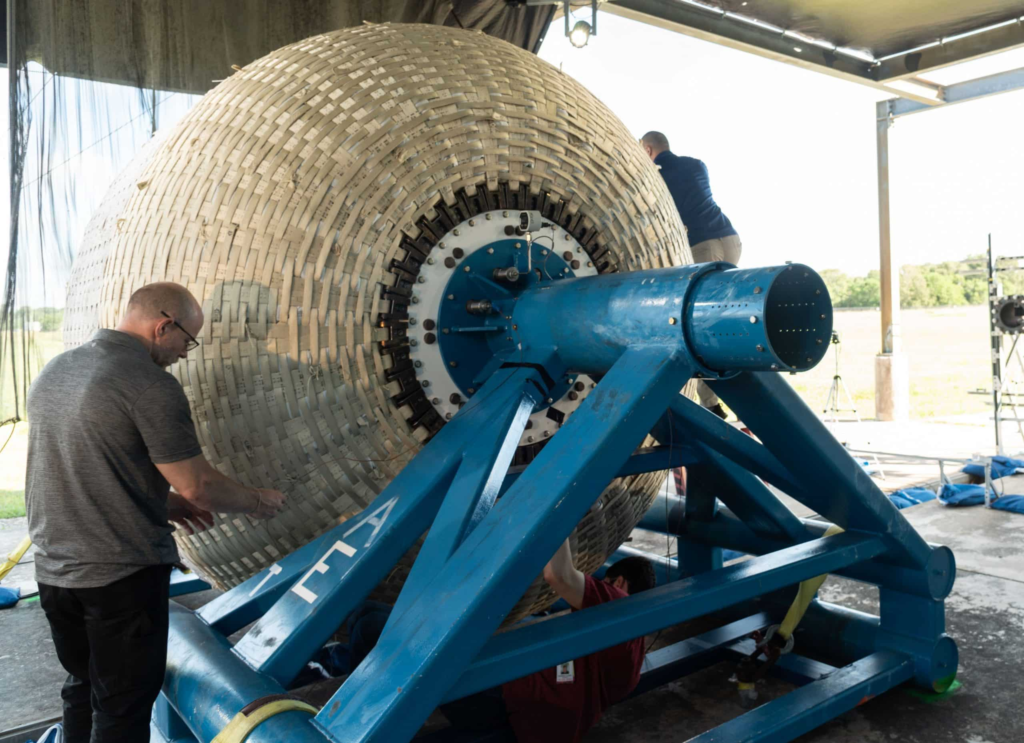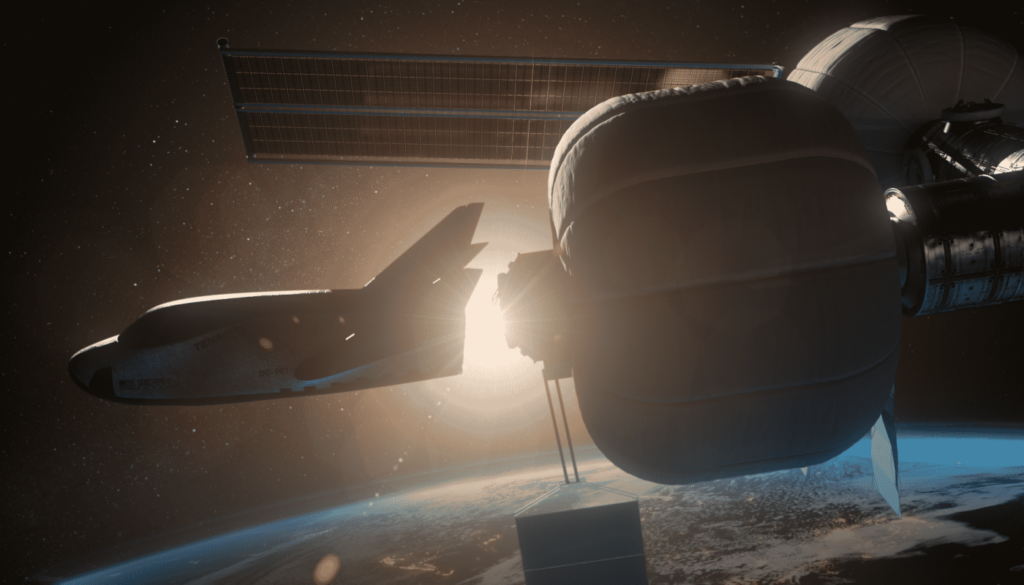
The Future of Space Habitats Is Making Significant Progress
One of the biggest challenges of creating habitats in space is the weight and size restrictions when being launched. Sierra Space is a company not only working on unique spacecraft such as Dream Chaser, but also a new type of destination in space. Named the LIFE habitat, it launches on a conventional rocket and inflates on-orbit to a large structure that is three stories tall, and 27 feet in diameter.
In the last couple of days, Sierra Space has provided some more updates on this system including a new milestone that was reached. Specifically, they just completed another Ultimate Burst Pressure test and are now the only active commercial space company to successfully meet multiple UBP trials. This comes in addition to more promising results from the test on this scale LIFE system.
In terms of future application, one of Sierra Space’s main contributions to the Orbital Reef station is the LIFE Habitat. To put it in perspective, a single LIFE module holds about 1/3 of the pressurized volume on the International Space Station. Here I will go more in-depth into yesterday’s test, the design of this habitat, when we can expect to see it in space, and more.
Explosive Test

Yesterday morning Sierra Space tweeted saying, “Sierra Space has successfully completed its second sub-scale Ultimate Burst Pressure (UBP) test and is the only active commercial space company to successfully meet multiple UBP trials.” This included a short video of the recent test from multiple angles. Not long ago in July of this year, we watched the first round of pressure tests of this system. However, his second test further establishes Sierra Space as a leader in commercial space station development.
This latest test was performed on November 15 under NASA’s NextSTEP project for space habitation systems, which is managed by the agency’s Marshall Space Flight Center. NASA subject matter experts and ILC Dover collaborated with Sierra Space on the test. Due to the explosive nature of the test, the team placed the sub-scale space habitat in the flame trench of the Saturn 1/1B test stand, where NASA tested rockets for the Apollo program.
Sierra Space’s LIFE forms part of the company’s in-space destinations technology portfolio. The inflatable module is a three-story commercial habitation and science platform designed for low-Earth orbit (LEO) that will allow humans to live and work comfortably in space. LIFE is constructed of high-strength “softgoods” materials, which are sewn and woven fabrics – primarily Vectran – that become rigid structures when pressurized. Sierra Space is working towards NASA softgoods certification and is already exceeding programmatic requirements that demonstrate LIFE has followed a successful systematic and comprehensive design, fabrication, and test program. The two sub-scale UBP tests in July and November achieved maximum burst pressure rates of 192 and 204 psi, respectively. Exceeding the safety requirement of 182.4 psi demonstrates that Sierra Space can meet the 4x safety factor required for softgoods inflatables within its current architecture at one-third scale.
After this recent test, Sierra Space CEO Tom Vice commented, “The LIFE habitat module is essential technology for enabling humans to safely and comfortably begin to develop new civilizations in space. This project will service many different opportunities for the new space economy, and the results of this most recent test and milestone are testament to the progress our team is making to enable the next chapter in space commercialization. We look forward to continuing to build this key element in our technology portfolio and paving the way for the development of advanced inflatable habitat systems and architectures.”
This series of sub-scale tests are designed to support LIFE’s overall, full-scale development and future inflatable habitats, as Sierra Space builds the next generation of inflatable habitat architectures. These early “fleet” leader tests provide the design and analysis data to determine the safety and reliability of the inflatable architecture systems. “Sierra Space is making incredible strides in the inflatable habitat technology development roadmap. In working with our partners ILC Dover and NASA, Sierra Space is quickly moving closer to softgoods certification,” added Shawn Buckley, LIFE Chief Engineer and Senior Director of Engineering at Sierra Space. “This second successful UBP test proves we can demonstrate design, manufacturing and assembly repeatability, all of which are key areas for certification.”
LIFE Habitat Overview

Now that we know more about yesterday’s test announcement and the promising results, we can take a closer look at the design of LIFE and its future test and launch schedule. Currently, Sierra Space is confident that full-scale LIFE UBP tests will begin in 2023, in order to complete NASA’s certification of the habitat’s primary structure for human use in space. Sierra Space is focused on performing critical risk reduction tests and assessing LIFE’s extensibility to multiple space destinations including the moon and Mars. As partially mentioned prior, among other missions in coming years, LIFE will serve as both a habitation and a payload element for the Orbital Reef commercial space station, a collaboration between Sierra Space and Blue Origin. Different animations of the station highlight its use and abundance of space.
In terms of the design of the LIFE Habitat, being that the main body is made out of fabric, a common question has to do with the impact of space debris, radiation, and other harmful space elements. To combat this, the layers of fabric, plus the internal outfitting, create ample safeguards against radiation and micrometeoroids. To be more specific, the LIFE habitat prototype is constructed of several soft goods layers, starting with the inner layer, called the bladder, which is made of urethane and is designed to keep the air inside the habitat without leaking. Next is the pressure shell layer, known as the restraint layer, which is a Vectran fabric weave that is strong enough to withstand the internal pressure needed for the crew to live & work comfortably in space. Sierra Space points out that this fabric weave is stronger than steel. Lastly, the outer layers consist of Micro Meteroroid Orbital Debris (MMOD) and Multi-Layer Insulation (MLI) which provide orbital debris and thermal protection.
Once inflated, the LIFE habitat is 27 feet in diameter and 27 feet long, including its vestibule. In total, the LIFE habitat’s pressurized volume is 300 cubic meters, a significant amount in space. Enough space to facilitate three floors outfitted with everything a crew of four astronauts would need to live in space and perform science missions. This includes science labs, robotics work stations, medical and sick bay, sleep and hygiene quarters, galley, exercise equipment, Sierra Space’s Astro Garden plant growth system, and ample storage room for crew supplies. As far as supporting humans, both air and water required to survive in space are expected to be delivered by logistics carriers to the habitat, where it is then stored until needed. The LIFE habitat has life support systems that regulate the air to maintain proper pressure, temperature, humidity, and oxygen levels. These life support systems recycle some of the air and water that is used to reduce the amount that has to be delivered to the habitat.
The LIFE habitat is currently designed to support four crew members living and working on long-duration missions, such as those to Mars. It comfortably houses six for missions in LEO, but can accommodate 12 crew for shorter periods of time such as those during which crew members transition. Because of its modular nature, additional habitats can be joined to each other to accommodate more crew, or for a variety of other purposes. The LIFE habitat is specifically designed to launch on commercial launch vehicles with a 5m fairing, providing multiple, low-cost launch options. It can also launch on the Space Launch System (SLS) since it expands only after it is on-orbit, making it easier and less expensive to transport.
More and more throughout the space industry, we are starting to see a slight shift as companies begin working on destinations in space rather than just ways to get there. Projects like Orbital Reef are very ambitious and require a large team each providing specific contributions. In Sierra Space’s case, they are making good progress on both Dream Chaser and the LIFE Habitat. In terms of the progress of this station, the project recently reached its one year anniversary since being picked by NASA to create a modern space station. Back in August, Orbital Reef successfully completed its System Definition Review (SDR) with NASA. The SDR is an important program milestone to establish the functional baseline for Orbital Reef. It demonstrated to NASA that the space station design is feasible and achievable while validating that the Orbital Reef system is on-track to proceed into the design phase.
Conclusion
Sierra Space has been working on the LIFE Habitat for quite a while now. Just yesterday the company announced a new milestone with the successful completion of a second UBP test on a 1/3 scale model. With this progress, Sierra Space expects to test a full scale system not long from now in 2023. We will have to wait and see how it progresses and the impact it has on the space industry.
